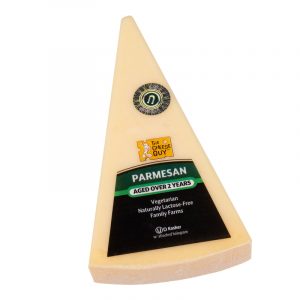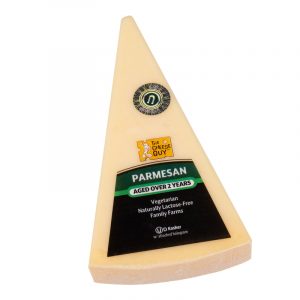Discover the Cheeses You Can Eat (Even if You Are Lactose Intolerant)
For dairy lovers, lactose intolerance is a gut bloating, bathroom-visiting drag. But it doesn’t have to be. “The biggest misconception is that people [who are lactose intolerant] cannot have dairy,” says Dr. Chris Cifelli, senior vice-president of nutrition research for the National Dairy Council. It’s not dairy but lactose, the naturally occurring sugars found in dairy, that upsets their digestive system. For most, dairy products that contain little to no lactose—natural hard cheeses, Greek- and Icelandic-style yogurts, and lactose-free milk—are safe to enjoy without the uncomfortable symptoms associated with drinking milk or eating ice cream.
WHAT IS LACTOSE INTOLERANCE?
Lactose intolerance is not an allergy, explains Jessica Sylvester, lead dietitian and founder of Florida Nutrition Group in Boca Raton, Florida. Gastrointestinal distress to dairy sugars “developed as an evolutionary mechanism to wean babies off breast milk as they got older.” This explains why young children rarely have symptoms associated with lactose intolerance; the condition tends to develop later in life.
But some adults who believe they are lactose intolerant may not actually be. It’s likely they are lactase non-persistent, instead. Lactase non-persistence occurs when the body’s production of lactase, the enzyme that breaks down the lactose in dairy, decreases with age. In other words, it’s the lack of lactase that leads to lactose intolerance, says Sylvester.
Researchers believe that more than 65% of the global population currently has some level of lactase non-persistence or lactose intolerance. In the U.S., the estimate is around 36%, according to Cifelli, with the highest rates found in communities whose heritage traces to regions outside of Europe and the Near East where traditional diets included little, if any, dairy.
The intensity of lactase non-persistence varies from individual to individual. Research conducted by the National Institute of Diabetes and Digestive and Kidney Diseases (NIDDK) suggests that many people who are lactase non-persistent or lactose intolerant can handle some dairy, up to 12 grams of lactose daily or a cup of milk.
DAIRY PRODUCTS LOW IN LACTOSE
Most people with lactose intolerance or lactase non-persistence can also tolerate dairy products that are naturally low in lactose. Hard cheeses such as cheddar, colby, Swiss, mozzarella and Monterey Jack “are virtually lactose-free,” Cifelli explains. Additionally aged cheeses such as Parmigiano Reggiano are virtually lactose free. At less than 1 mg lactose per 100 grams even the Italian Ministry of Health allows it to be labeled as such.
“Ninety percent or more of the lactose in milk is removed along with the water and whey during the cheesemaking process. The remaining lactose is fermented into lactic acid.” Hard cheeses contain less than one gram of lactose per 1.5 ounce serving. Butter, cream, cream cheese, and lactose-free products also all have less than one gram of lactose per serving.
CHEESE VERSUS MILK
While soft, fresh and processed cheeses—cottage cheese, ricotta, burrata and others—contain significantly more lactose than hard cheeses, they still have far less than that found in milk, yogurt and ice cream: 1 to 6 grams/serving versus 6 to 14 grams/serving. According to the NIDDK’s recommendations, most people experiencing lactase non-persistence or lactose intolerance should be able to handle at least one, if not multiple, servings of these types of low-lactose foods each day.
This is good news for more than just the taste buds of those who experience GI distress after consuming dairy. “Reducing consumption of dairy foods due to concerns about lactose intolerance can result in a lower consumption of milk’s nutrients and the health benefits they provide,” says Cifelli, and plant-based alternatives don’t always provide a good substitute for calcium, protein, phosphorus, potassium and others. While supplements and the increased consumption of high-calcium foods like canned fish and dried beans can help fill the void, adding a small amount of lactose to the diet also provides those much-needed nutrients.
HOW TO MANAGE LACTOSE INTOLERANCE
Although lactose intolerance is incurable, many people may be able to improve their condition by ingesting small amounts of low-lactose dairy over time. There may even be a way to prevent it from developing altogether. “Evolution suggests that if we grow up eating dairy and raise our kids to eat and drink dairy, they will be less likely to stop producing lactase,” says Sylvester.
Those currently experiencing the gas, bloating and diarrhea commonly associated with lactose intolerance or lactase non-persistence can be tested for the condition by a doctor. Confirming the presence of lactose intolerance and determining the severity of the condition can help you to come up with management strategies that don’t require giving up many of the dairy foods you love.
Our Lactose Free Cheeses
-
 Parmesan – Over 2 Years Aged$11.25
Parmesan – Over 2 Years Aged$11.25 -
 3 Year Aged Parmesan$12.50
3 Year Aged Parmesan$12.50 -
 4 Year Aged Parmesan$13.00
4 Year Aged Parmesan$13.00 -
 Raw Milk Sharp Cheddar$9.75
Raw Milk Sharp Cheddar$9.75 -
 Viney Sheep$15.75
Viney Sheep$15.75 -
 Parmesan – Over 2 Years Aged$10.25
Parmesan – Over 2 Years Aged$10.25
